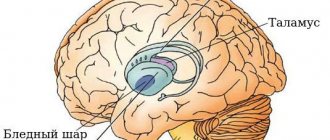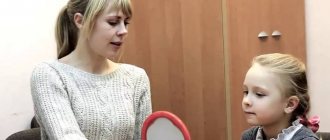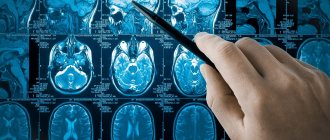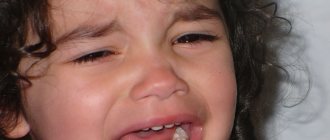Article:
Speech therapy is the science of speech development disorders, their overcoming and prevention through special correctional training and education.
The term speech therapy is derived from the Greek words: logos (word, speech), peideo (educate, teach), which translated means “speech education.”
The subject of speech therapy as a scientific discipline is the study of the patterns of training and education of persons with speech disorders and associated deviations in mental development. Speech therapy is divided into preschool, school and adult speech therapy.
The main tasks of speech therapy are as follows:
- studying the patterns of special education and upbringing of children with speech disorders;
- determination of the prevalence and symptoms of speech disorders in children of preschool and school age;
- study of the structure of speech disorders and the influence of speech disorders on the mental development of the child;
- development of methods for pedagogical diagnosis of speech disorders and typology of speech disorders;
- development of scientifically based methods for eliminating and preventing various forms of speech impairment;
- organization of speech therapy assistance.
The practical aspect of speech therapy is to prevent, identify and eliminate speech disorders. Theoretical and practical tasks of speech therapy are interconnected.
The main goal of speech therapy is to develop a scientifically based system of training, education and re-education of people with speech disorders, as well as the prevention of speech disorders.
To solve these problems, the following is necessary:
— the use of interdisciplinary connections and the involvement of many specialists who study speech and its disorders (psychologists, neuropsychologists, neurophysiologists, linguists, teachers, doctors of various specialties, etc.);
— ensuring the relationship between theory and practice, connecting scientific and practical institutions for faster implementation of the latest scientific achievements into practice;
— implementation of the principle of early detection and overcoming speech disorders;
— dissemination of speech therapy knowledge among the population for the prevention of speech disorders.
The solution to these problems determines the course of speech therapy intervention.
The main focus of speech therapy is speech development, correction and prevention of speech disorders. In the process of speech therapy work, the development of sensory functions is provided; development of motor skills, especially speech motor skills; development of cognitive activity, primarily thinking, memory processes, attention; formation of the child’s personality with simultaneous regulation and correction of social relationships; impact on the social environment.
The organization of the speech therapy process makes it possible to eliminate or mitigate both speech and psychophysical disorders, contributing to the achievement of the main goal of pedagogical influence - the education of a person.
Speech therapy intervention should be aimed at both external and internal factors causing speech disorders. It is a complex pedagogical process aimed primarily at the correction and compensation of speech impairments.
The connection between speech therapy and other sciences
Speech therapy is closely related to many sciences. In order to successfully correct and prevent various speech disorders and to have a comprehensive impact on the individual, it is necessary to know the symptoms of speech disorders, their etiology, mechanisms, the relationship between speech and non-speech symptoms in the structure of speech disorders.
There are intrasystem and intersystem connections. Intrasystemic ones include connections with pedagogy, various branches of special pedagogy: deaf pedagogy, typhlopedagogy, oligophrenopedagogy; methods of teaching native language, mathematics; with speech therapy rhythm, general and special psychology. Intersystem connections include connections with medical, biological and linguistic sciences.
The natural scientific psychophysiological basis of speech therapy is the doctrine of the patterns of formation of conditioned reflex connections, the doctrine of P.K. Anokhin about functional systems, the doctrine of the dynamic localization of mental functions (I.M. Sechenov, I.P. Pavlov, A.R. Luria) and modern neuropsycholinguistic theory of speech activity.
A word is a signal of a special property, a means of generalization and abstraction. Taking into account the complex neurophysiological mechanisms of speech activity allows us to more effectively build speech therapy work to correct speech disorders, to compensate for impaired speech and non-speech functions.
Speech therapy uses knowledge of general anatomy and physiology, neurophysiology about the mechanisms of speech, the cerebral organization of the speech process, the structure and functioning of analyzers that take part in speech activity.
To understand the mechanisms of speech disorders and identify patterns of the correction process, knowledge about the dynamic localization of higher mental functions and the cerebral organization of speech is important.
Increased originality
Test questions 1. Explain the essence of the phenomenon of viscous friction. What is the nature of the internal friction forces of a fluid? Viscosity or internal friction is the property of fluid bodies (liquids and gases) to resist the movement of one part relative to another. This phenomenon determines the dissipation (absorption) of energy during deformation of the medium. During shear deformation, the viscosity is called shear viscosity. When the volume is deformed (universal compression), bulk viscosity appears. In this case, we will only touch upon the issue of shear viscosity. The essence of the phenomenon is that moving layers of gas or liquid entrain neighboring layers and, conversely, stationary layers (or moving at a lower speed) slow down faster neighboring layers. Thus, internal friction forces (or viscous forces) act between any adjacent layers of the medium under consideration. The mechanism by which these forces arise is the transfer of momentum (amount of motion) from one layer to another.2. What is the coefficient of dynamic viscosity? In what units is viscosity measured in the SI system?
The coefficient of dynamic viscosity is a value numerically equal to the force of internal friction with which one layer drags or slows down another layer of liquid, provided that the contact area of the layers and the velocity gradient . In the SI system, the unit of dynamic viscosity is taken to be the viscosity of a medium in which one layer drags or inhibits another with a force of , if the contact area of the layers and the velocity gradient are .
3. What forces act on a body moving in a liquid?
A body immersed in a liquid and remaining in equilibrium afloat is acted upon by two forces: the force of gravity and the buoyant force equal to it (and equal to the weight of the liquid displaced by the immersed volume of the body). Three forces act on a body immersed in a liquid and sinking: the force of gravity, which is unequal to it (less), the buoyancy force (equal to the weight of the liquid displaced by the immersed volume of the body), as well as the frictional force during movement, which largely depends on the speed of immersion and the viscosity of the liquid . A body immersed in a liquid and lying tightly at the bottom is acted upon by three forces: the force of gravity, the unequal buoyant force, and the reaction force from the bottom. In this case, the buoyant force decreases by an amount equal to the weight of the liquid occupied by that part of the body volume under which there is no water
4. Define laminar and turbulent fluid flow.
Turbulent flow is a fluid flow in which its particles perform unsteady and disordered movements along complex trajectories, leading to mixing of layers. Laminar is an ordered flow of fluid in which the trajectories of motion of neighboring particles differ little from each other.
5. Write down the Stokes formula and indicate the conditions for its applicability.
For spherical bodies, the modulus of the viscous friction force is determined by the Stokes formula (1) where r is the radius of the ball; V is the speed of its movement relative to the liquid. It is important to note that formula (1) is valid only in the case of laminar fluid flow relative to the ball (the speed of the ball should be small), and the fluid extends infinitely in all directions, i.e. The dimensions of the vessel in which the liquid is located must be much larger compared to the dimensions of the ball.
6. Determine the magnitude of the friction force acting on a steel ball with a diameter of 3 mm falling at a speed of 0.75 m/s in a liquid with a viscosity coefficient of 1.5 Pa.s. F=6*3.14*1.5*0.003*0. 5=0.063
7. Why does the ball accelerate at the beginning of its movement and then move uniformly? What is a velocity gradient? At the beginning of the ball's movement, the movement will be accelerated due to the acceleration of gravity. As the speed increases, the resistance force also increases, and the acceleration of the ball decreases. There comes a moment when the forces acting on the ball are balanced, the acceleration becomes zero, and the movement of the ball becomes uniform in section L. The velocity gradient is the change in the speed of two layers of liquid dV at the distance between the layers dX.
8. Write down the working formula, explain the conditions for its use and the reason for starting to measure time not from the surface of the liquid.
The upper mark is placed several centimeters below the upper level of the liquid to ensure uniform movement of the ball in the liquid. 9. List the main sources of measurement errors carried out in this work.
The concepts of ZRR and ONR in speech therapy
Delayed speech development
, is typical for children under 4 years of age. The level of development of the speech abilities of a child with this diagnosis is noticeably behind his peers. With timely contact with a speech therapist, the deviation is successfully eliminated.
OSD – general speech underdevelopment.
The concept includes versatile pathologies in the child’s speech development (lexical, grammatical, phonetic and other errors in the pronunciation and formulation of words and sentences).
ONR can be observed with alalia, dysarthyria, etc. In speech therapy, ONR is divided into 4 levels, which are determined by the degree of deviations from the norm. Presented in the table:
| OHP levels | Characteristic |
| Level 1 |
|
| Level 2 |
|
| Level 3 |
|
| Level 4 |
|
Expert opinion
Margarita Sergeevna S.
Speech pathologist and speech pathologist with 15 years of experience working in various speech correction centers with children of different ages.
The presented division is necessary for a speech therapist to make a correct diagnosis and subsequent treatment.
Subject and tasks of speech therapy
Definition 1
Speech therapy is the science of speech disorders, ways of preventing and overcoming them through special correctional training.
Speech therapy is one of the sections of special pedagogy - defectology.
The subject of speech therapy as a scientific discipline:
- speech disorders;
- training and education of persons with speech disorders, correctional intervention system.
Speech therapy can be preschool, school and adult. The main tasks of speech therapy include:
- study the ontogenesis of speech activity in various speech disorders;
- determine the prevalence, symptoms and degree of manifestation of speech disorders;
- identify the dynamics of the development of children with speech disorders, the impact of speech disorders on the process of formation of their personality, mental development, various types of activities;
- to study the features of speech formation and speech disorders in children with developmental disabilities;
- identify the etiology, mechanisms, structure and symptoms of speech disorders;
- develop methods for pedagogical diagnosis of speech disorders and systematize them;
- improve methods of preventing speech disorders;
- develop an organization of speech therapy assistance.
Are you an expert in this subject area? We invite you to become the author of the Directory Working Conditions







